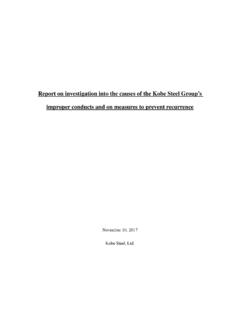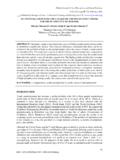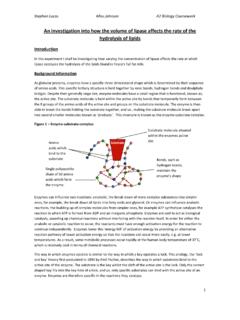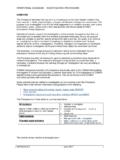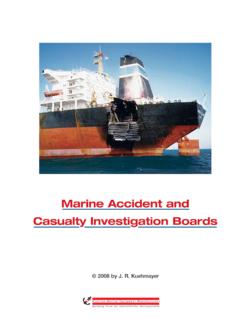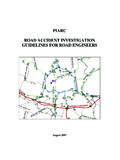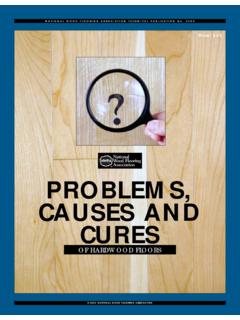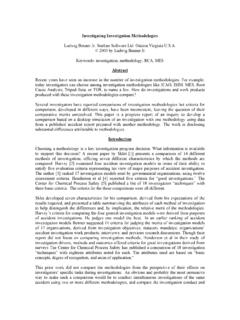Transcription of The Nursing Home Expert Panel’s Falls Investigation Guide ...
1 The Nursing home Expert Panel s Falls Investigation Guide toolkit : How-To Guide [Page intentionally left blank] Table of Contents Introduction .. 1 Oregon s Quality Agenda .. 1 The Project Falls Management .. 1 Nursing home Expert Panel Members .. 2 What Providers Have to Say about the Investigation Guides .. 2 Components of an Effective Investigation Process .. 3 Applying Root Cause Analysis to Falls 3 How Does Your Investigation Measure Up? .. 4 Implementing Change and Sustaining Improvement .. 4 The Falls Investigation Guides .. 5 1. Falls Investigation Guide [2 pages] 2. Environment and Equipment Drill-Down [2 pages] 3. Medications Drill-Down [2 pages] 4. Communication Drill-Down [2 pages] 5. Falls Investigation Guide for First Responders [2 pages] Appendix A: Falls Investigation Guide Documentation Checklist .. A-1 Appendix B: fall Investigation Form Examples .. B-1 1. Example: Falls Investigation Form [8 pages] 2.
2 Example: Nursing Facility Falls Investigation Form [7 pages] 3. Example: CBC Falls Investigation Form [7 pages] Appendix C: Integrating the Guides into the Investigation Process .. C-1 Using the Guides .. C-1 How to Integrate the Falls Guides into the Investigation Process .. C-2 Appendix D: Glossary of Terms .. D-1 5-whys .. D-1 Contributing Factors .. D-2 Plan-Do-Study/Check-Act (PDS/CA) .. D-2 Model for Improvement .. D-2 Root Cause Analysis (RCA) .. D-2 SBAR Communication (Situation-Background-Assessment-Recomme ndation) .. D-2 SMARTS for Action Planning .. D-3 Appendix E: Additional Resources .. E-1 1. Resource Root Cause Analysis Case Example [1 page] 2. Tool PDSA Worksheet for Testing Change [1 page] 3. Article Putting Patient Safety First: Creating a culture of patient safety in a Nursing facility improves clinical outcomes and diminishes liability [link only] 4. Article Rethinking the Use of Position Change Alarms [link only] 5.
3 Resource State Operations Manual Appendix PP Guidance to Surveyors for Long Term Care Facilities [link only] 6. Resource Oregon Administrative Rules for Long Term Care Settings [link only] 1 The Nursing home Expert Panel s - Introduction Oregon s Quality Agenda In February, 2008 the Oregon Patient Safety Commission convened its Nursing home Expert Panel to encourage quality improvement in Nursing homes. The stated goal was to better align Nursing home patient safety efforts around a well-articulated and interlocking set of principles, values and assumptions. The project started with a straightforward question: Could the Expert panel identify critical safety concerns and then offer a standardized set of improvement tools? Since then, the work has gathered momentum and is now part of a larger effort to re-think quality efforts within long term care. The cornerstones of this new approach are: Responsive regulation (an approach that encourages Nursing homes to design their own safe systems, while regulating those systems to ensure that practices are actually applied.)
4 Please see the Commission s website for additional information located under the Nursing home Workgroup Issues Report). Alignment of interests (the belief that improvement requires everyone, including Nursing homes, regulators, consumers and family, and purchasers to have a aligned goals in a quality agenda) Standardized quality improvement tools and techniques (we need to create well-tested, evidence-based approaches). The Expert panel has led the effort to develop standardized tools. The Project Falls Management With a focus on safety and cooperative quality improvement, the Expert Panel set out to address trends identified through the Oregon Patient Safety Commissions adverse event reporting program as well as common citations in Oregon s long term care environments. The Expert Panel chose to work on Falls management; specifically, reducing Falls with injury and repeat Falls . Upon review of Falls data, survey citation data, and incident reports, the Expert Panel concluded that Nursing homes and community based care settings would benefit from improved systems for Falls Investigation .
5 This led to the development of a simple, easy to use, set of guides to investigate Falls built around evidence-based quality improvement principles. The Panel focused on the three most common contributing factors to Falls medications, environment/equipment, and communication and developed Investigation guides to address each one as well as an overarching Falls Investigation Guide . The guides take the first responder through an initial Investigation and continue on to direct follow-up and review per facility policy. Based on feedback from pilot participants, a condensed version of the Investigation guides was also created to Guide a fall s first responder through the initial Investigation process. Additionally, a documentation checklist and a Falls Investigation form were created to further aid facilities in the Investigation process. Using these tools, two pilot participants developed their own Falls Investigation forms which have been included in this toolkit .
6 It is the Panel s hope that other facilities will incorporate the information provided into their systems as well and make it their own. Falls Investigation Guide toolkit : How-To Guide 2 Nursing home Expert Panel Members Special thanks to all the Nursing home Expert Panel members for their hard work and dedication to this project. Their participation was voluntary and reflects their commitment to improving the quality and safety of long term care in Oregon. Members included: Libby Darnall, RN, Seniors & People with Disabilities Sharon Faulk, RN, Pinnacle Healthcare Patti Garibaldi, RN, BA, RAC-CT, Consonus Healthcare Amy Carl, Oregon Patient Safety Commission Ruth Gulyas, Oregon Alliance of Senior & Health Services Demi Haffenreffer, RN, MBA, Haffenreffer & Associates Linda Kirschbaum, Oregon Health Care Association Valerie Van Buren, MPH, Acumentra Health and Oregon Patient Safety Commission Additional thanks to Karen Jones, Acumentra Health, for her work on formatting the Investigation Guides.
7 What Providers Have to Say about the Investigation Guides Without the written Falls Investigation Guide , it is easy for the nurses to forget about some factors that could contribute to a fall or to skip over steps in the Investigation process. The 5-Whys have also forced us to dig deeper into the root causes of each fall and allowed us to implement systems to prevent similar Falls in the future. Since we started using the Guide , we have seen a steady decline in our Falls rates, and we hope that over time as we get better and better at using it, we will continue to see fewer Falls and fewer injuries! Erin Cornell Director of Health Services Rose Villa Using the Falls Investigation Guide helped my staff feel more empowered. They were active participants in the Investigation ; we used the valuable suggestions from front-line staff to make care plan interventions. It helped us be proactive about trying to keep another fall from happening the same resident and other residents.
8 Leslie Pena, LPN Administrator Mount Angel Towers Quality is everyone s responsibility. W. Edwards Deming Falls Investigation Guide toolkit : How-To Guide 3 Components of an Effective Investigation Process Applying Root Cause Analysis to Falls Investigations To understand why Falls or other adverse events occur, improvement experts champion the use of root cause analysis (RCA). RCA requires a systematic, intensive, and in-depth review to learn the most basic reasons for the adverse event. The approach has a formal logic and a defined methodology. The goal is to understand the problem in sufficient depth to effectively eliminate the risk of future injury. RCA can be used to analyze a single fall as well as to look at multiple Falls so that patterns can be identified and system wide changes can be made. For more information on RCA, please refer to Oregon s Guide to Root Cause Analysis in Long Term Care, Investigating with a Different Lens.
9 [Available at: ]. The Falls Investigation Guides walk the investigator(s) through the RCA process in order to: Determine what happened. Identify factors that contributed to the event ( , the fall (s)). Develop an action plan to reduce the likelihood of a similar event. The components of an effective RCA outlined in Oregon s Guide to Root Cause Analysis are: 1. Gather and document initial information 2. Fill in the gaps 3. Analyze 4. Develop an action plan 5. Implement action plan and evaluate results The diagram below summarizes how the Falls Investigation Guides correspond to the steps in an RCA. Additional quality improvement tools to assist you in your Investigation are noted to the left. Information about these tools can be found within the Falls Investigation Guides and in the Glossary of Terms. Useful tools Oregon s RCA process steps The Investigation guides Gather & document initial information Fill in the gaps Analyze Develop an action plan Evaluate effectiveness Falls Investigation for First Responders/ Charge Nurses Falls Investigation Guides Falls Investigation Guide Environment & Equipment Drill-Down Medications Drill-Down Communication Drill-Down 5-Whys PDSA SMARTS Falls Investigation Guide toolkit : How-To Guide 4 How Does Your Investigation Measure Up?
10 You can compare your facility s current practices related to Falls investigations with those outlined in the Falls Investigation Guides using the Falls Investigation Guide Documentation Checklist located in Appendix A. Note that this document is not meant to replace the guides, which contain much more detail and process information. It is, however, a tool to help you identify any gaps you may currently have in your processes. Implementing Change and Sustaining Improvement Once a facility has decided to make a change in how it investigates Falls , it is important to plan the change in order to ensure effective implementation. One tool that can help structure this process is the Model for Improvement; a simple tool for accelerating improvement. It is not meant to replace change models that organizations may already be using, but rather to accelerate improvement. This model has been used very successfully by hundreds of health care organizations to improve many different health care processes and outcomes.
